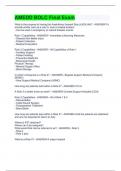Financial economics – Alpha
- Focuses on decision making under uncertainty → i.e. making decisions now for future outcomes
- Characteristics of Financial Economics:
o Normative → how people should behave
o Positive → can set up and test hypotheses
- Utility functions (UF) depict preferences
- Utility → a desired abstract quantity you obtain from making a certain choice (measured in utils)
- Ordinal → can rank choices but cannot say by how much one is better than the other (e.g. agree, strongly
agree)
- Cardinal → can measure how much one choice is better than the other (utils in interval scales like temperature
or IQ scores)
Von Neumann-Morgenstern utility theory
- The foundation of all asset pricing theory
- Assumes that for every decision maker, there exists a cardinal utility theory
- This UF transform all the possible and uncertain outcomes of a specific decision (choice) into a certain level
of utility (utils)
- A rational decision maker wants to maximise the expected value of their UF
Mathematical expectation
- Arithmetic mean
o A representative value of ethe random variable (RV) X under consideration
o Example: Rolling a dice
▪ The RV is X: the value of the dice
▪ The distribution of X: f(x) = 1/6
▪ Therefore E(X) = 1*(1/6) + 2*(1/6)+…. 6(1/6) = 3.5
• Impossible to get 3.5 on a dice. Also 3 and 4 are NOT more likely as all have a p=1/6
▪ Might not always exist
- Variance
o How representative is µ of the distribution of X
o Standard deviation of X is the square-root of the
variance of X
o Large variance means that the mean is not
representative of the distribution of X
o Small variance means that the mean is representative of the distribution of X
- Skewness
o How asymmetric is the distribution of X around µ →
how man y values do we observe that are
higher/lower than the mean
o When positive skewness, it means there are more
positive values than negative values
- Kurtosis
o How likely is it for the RV to take on values that are
VERY FAR from µ
o When >3 (leptokurtic) when <3 (platykurtic)
- Focuses on decision making under uncertainty → i.e. making decisions now for future outcomes
- Characteristics of Financial Economics:
o Normative → how people should behave
o Positive → can set up and test hypotheses
- Utility functions (UF) depict preferences
- Utility → a desired abstract quantity you obtain from making a certain choice (measured in utils)
- Ordinal → can rank choices but cannot say by how much one is better than the other (e.g. agree, strongly
agree)
- Cardinal → can measure how much one choice is better than the other (utils in interval scales like temperature
or IQ scores)
Von Neumann-Morgenstern utility theory
- The foundation of all asset pricing theory
- Assumes that for every decision maker, there exists a cardinal utility theory
- This UF transform all the possible and uncertain outcomes of a specific decision (choice) into a certain level
of utility (utils)
- A rational decision maker wants to maximise the expected value of their UF
Mathematical expectation
- Arithmetic mean
o A representative value of ethe random variable (RV) X under consideration
o Example: Rolling a dice
▪ The RV is X: the value of the dice
▪ The distribution of X: f(x) = 1/6
▪ Therefore E(X) = 1*(1/6) + 2*(1/6)+…. 6(1/6) = 3.5
• Impossible to get 3.5 on a dice. Also 3 and 4 are NOT more likely as all have a p=1/6
▪ Might not always exist
- Variance
o How representative is µ of the distribution of X
o Standard deviation of X is the square-root of the
variance of X
o Large variance means that the mean is not
representative of the distribution of X
o Small variance means that the mean is representative of the distribution of X
- Skewness
o How asymmetric is the distribution of X around µ →
how man y values do we observe that are
higher/lower than the mean
o When positive skewness, it means there are more
positive values than negative values
- Kurtosis
o How likely is it for the RV to take on values that are
VERY FAR from µ
o When >3 (leptokurtic) when <3 (platykurtic)







